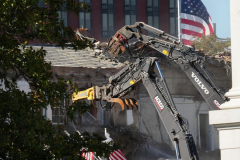The images are arresting. Where a portion of the stately East Wing of the White House once stood, there’s now a demolition site – complete with construction equipment and debris, the side of the building completely torn off.
In its place, if all goes according to plan, will arise the 90,000-square-foot, $250 million ballroom that President Donald Trump announced in July, a grand event space that will dwarf the existing 55,000-square-foot executive mansion.
To Washington denizens and tourists alike, it’s a shocking sight. President Trump, after all, had stated that the construction wouldn’t “interfere with the current building.” The new ballroom will be the biggest structural change to the White House since the renovation and expansion of the East Wing in 1942.
Why We Wrote This
President Trump’s new ballroom, and proposed arch, will reportedly be funded by private donors. But beyond expense, his modus operandi seems to be to go for it and deal with any consequences later.
Tuesday morning, a day after demolition began, a scrum of White House press photographers with a ladder and telephoto lenses gathered outside the fenced perimeter to capture what they could through the trees and around other obstacles. The best photos have come from inside the neighboring Treasury Department, though employees have since been ordered to stop sharing.
Late Tuesday, the Washington Post reported that “much of the East Wing” had been destroyed, judging by a photo the paper had obtained. The East Wing includes offices for the first lady, her team, and the White House social secretary.
For Mr. Trump, a real estate developer by profession, the ballroom project is by far the biggest example yet of how his public and private personas have merged. Since his second inauguration in January, he has moved swiftly to put his own touches on his residence and workspace – adorning the Oval Office with gold filigree, paving the Rose Garden and turning it into a private cafe, and adding 88-foot-tall flagpoles to the North and South Lawns.

President Donald Trump speaks during a lunch with Republican senators in the Rose Garden of the White House, Oct. 21, 2025, in Washington.
The John F. Kennedy Center for the Performing Arts – which Mr. Trump took over in February as chair – is also getting a makeover, as is the bathroom in the White House’s famed Lincoln bedroom. No detail is too small, including the type of grass planted in the capital’s public spaces, even the traffic circles.
“I know more about grass than any human being, I think, anywhere in the world,” Mr. Trump, owner of many world-class golf courses, boasted in a meeting with U.S. Park Police officers in August.
For that matter, no project is too big. The president has announced plans for a grand arch – similar to the Arc de Triomphe in Paris – to be constructed on a traffic circle at the end of the Arlington Memorial Bridge, between the Lincoln Memorial and Arlington National Cemetery. At a dinner last week for donors contributing funds for the new ballroom, Mr. Trump held up a model of the planned arch, inevitably dubbed the “Arc de Trump,” which he hopes to install by July 4 – the 250th anniversary of the nation’s founding.
The new arch will also reportedly be funded by priv





